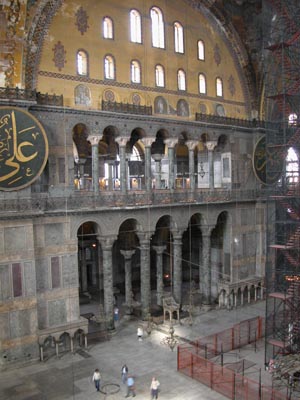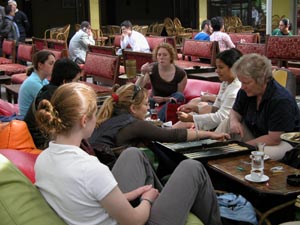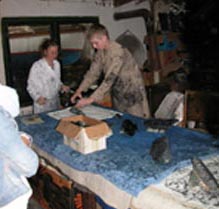
![]()
GROUP
JOURNAL FOR
earlham collEge - handS on craft tour
May 10, 2005 - June
01, 2005
Day 02
May 11, 2005 Istanbul, Turkey
The text and the pictures are submitted by Nick Heynen,
heyneni@earlham.edu
Today was a big day. Breakfast at the hotel was excellent--lots of fruit, bread, cheese and tea. I am loving Turkish tea (çay). After breakfast we a got together and went to the Basilica Cistern.
The
Basilica Cistern was
awe-inspiring! It's a HUGE underground room built by the Romans in the
6th century CE to filter and store drinkable water for the
saltwater-heavy Istanbul. The immense room's high ceiling is supported
by hundreds of large pillars. Some of the pillars were built by the
Romans, but in the interest of completing the cistern quickly, the
Romans also took columns and pillars from existing or fallen buildings
to construct it; adding material if the foreign pillars were too short
and cutting them down if they were too long. As a result the cistern
has a beautiful "patchwork quilt" of columns which one can view by
strolling the recently-constructed (read: in the last decade) pathway
that leads through the cistern. Some of the columns came from classical
Greek buildings.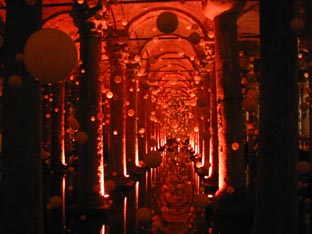
The two most interesting columns rested on two identical sculptures of the face of Medusa. One of these sculptures rested upside-down and the other rested on its side, obviously being useful to the Romans only to prop up the ceiling.
Another interesting aspect of the Basilica Cistern is the way the city of Istanbul is using it now. Aside from being a historical site of interest, they also use the space as an art museum for displaying local non-traditional artwork. This was strange because the location did not seem suited as an art gallery, being very dark and having water constantly dripping from the ceiling. It was amusing to find new art among the thousands-year-old pillars of the Cistern. There was European classical music playing on a boom box somewhere in the cistern as well, adding to the patchwork quilt effect of the place.
From the Cistern we walked to the Turkish and Islamic Art Museum. In the lobby of the museum we had tea again as Meli gave us a brief history of Istanbul, starting long before the Persian invasion of Greece. The museum itself was very nice, with Turkish and English labels on all of the displays which helped us practice our Turkish. There were a few sculptures, many old rugs, metal and ceramic pots, turban pieces and wooden and metal chests. Elly gave a talk about woodcarvings, and Sophia gave a talk about the use of tulips in Turkish art.
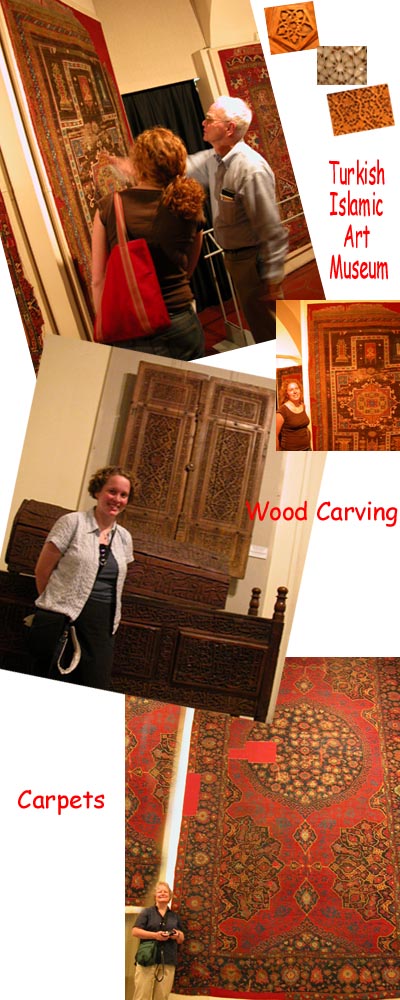 From there we walked to the Aya Sophia sanctuary/mosque/museum. This
was in many ways even more impressive than the Blue Mosque, not the
least of which was because of its history. Aya Sofia was built by the
Roman emperor Justinian in the 6th century CE. It served as a Christian
sanctuary inside the Roman Hippodrome (which is now mostly dismantled).
Upon seeing the completed building, Justinian is supposed to have sunk
to his knees and cried out, "Now Solomon, I have surpassed your fame: my
temple is grander than yours!" When Istanbul was conquered by Fatih the
Conqueror and the Ottomans in 1453, Aya Sofia was converted to a
mosque. Thankfully, however, despite the Islamic iconoclasism, they did
not remove the sanctuary's magnificent Christian mosaics, but simply
whitewashed over them. After Attatürk declared the independent republic
of Turkey he had Aya Sofia turned into a museum so that both religions
could enjoy it. The whitewash has now been carefully removed,
uncovering the incredibly beautiful mosaics for all to see.
From there we walked to the Aya Sophia sanctuary/mosque/museum. This
was in many ways even more impressive than the Blue Mosque, not the
least of which was because of its history. Aya Sofia was built by the
Roman emperor Justinian in the 6th century CE. It served as a Christian
sanctuary inside the Roman Hippodrome (which is now mostly dismantled).
Upon seeing the completed building, Justinian is supposed to have sunk
to his knees and cried out, "Now Solomon, I have surpassed your fame: my
temple is grander than yours!" When Istanbul was conquered by Fatih the
Conqueror and the Ottomans in 1453, Aya Sofia was converted to a
mosque. Thankfully, however, despite the Islamic iconoclasism, they did
not remove the sanctuary's magnificent Christian mosaics, but simply
whitewashed over them. After Attatürk declared the independent republic
of Turkey he had Aya Sofia turned into a museum so that both religions
could enjoy it. The whitewash has now been carefully removed,
uncovering the incredibly beautiful mosaics for all to see.
The inside of Aya Sofia is old and beautiful, though very difficult to photograph due to its size. Like the Cistern, it is also a bit of a patchwork. Eight of the pillars from the original construction were taken by Justinian from the Temple of Artemis (one of the seven wonders of the world) as a way of showing the building's grandeur. Not to be outdone, when the sanctuary was converted to a mosque, the Ottomans installed giant marble urns which they took from Pergamum. The end result is a simply mind-blowing interior space full of history and beauty. If there had been less people in there, I think Aya Sofia might have been my favorite site thus far. Julie gave a talk on mosaics and Meli outside the museum.
We then set out by tram to a hookah café. Along the way I got separated from the group by accident when the tram conductor announced the wrong station and I got off when no one else did. I caught up quickly though, and all was well. The hookah café was a nice place for us to relax and socialize after our long day. Some played backgammon, some drank tea or Turkish coffee, almost everyone tried the hookahs, and Meli read Julie and Brent's fortunes in their coffee cups.
The rest of the evening, including
dinner, was free time. Most of us went back on the tram to Sultan Ahmed
to shop and eat. Now, as we trickle back to our hotel, we all look
forward to a little time to rest, reflect on our day, and prepare for
tomorrow.